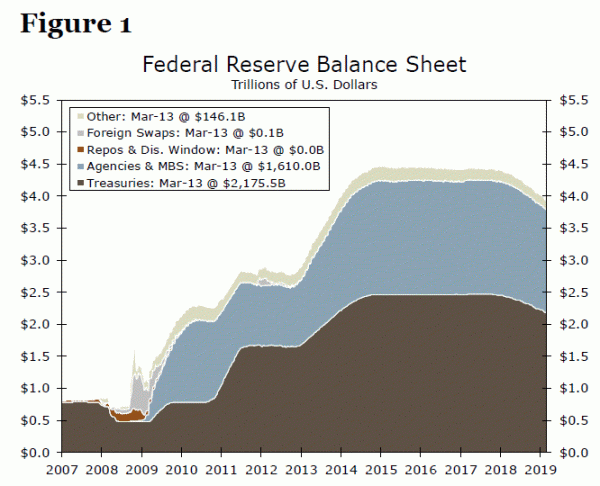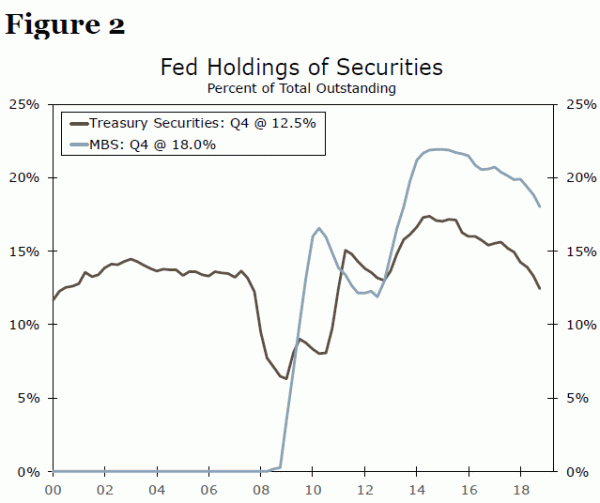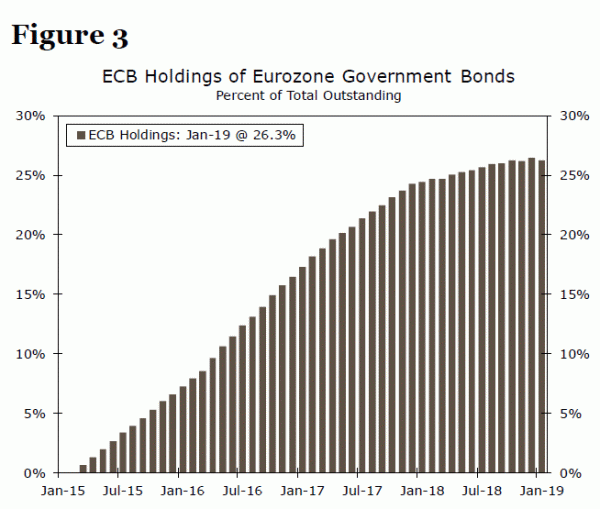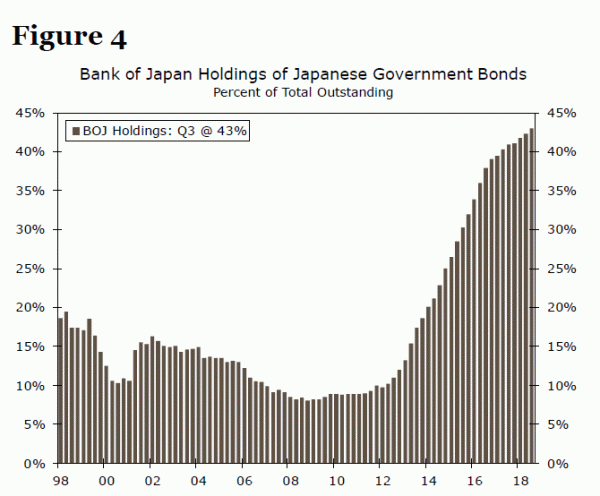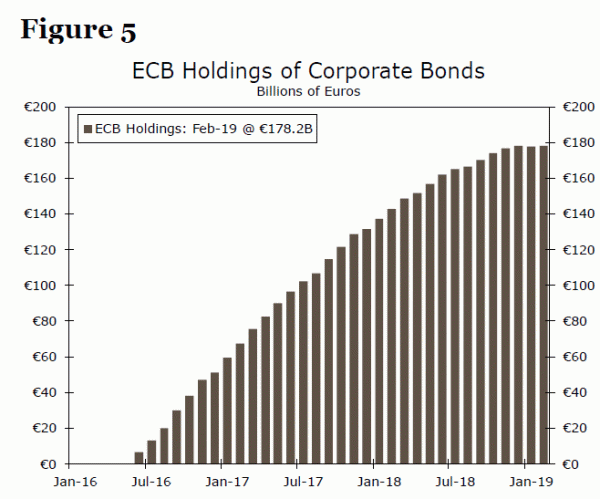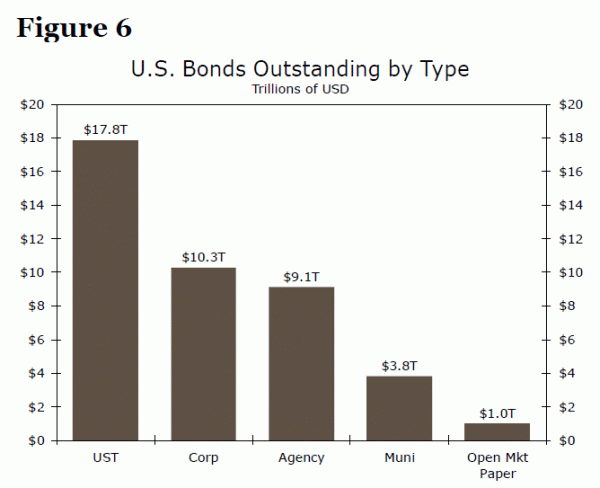Executive Summary
In the third of a series of reports examining how the Fed’s framework and toolkit may evolve in the coming years, we discuss the potential for the Federal Open Market Committee (FOMC) to return to quantitative easing (QE).1 Because the FOMC views changes in the fed funds rate as its primary means for changing the stance of monetary policy, the committee would first cut rates all the way back to 0%, if necessary, when the next economic downturn arrives. But the experience with QE shows that it can lend some monetary policy support when interest rates become extraordinarily low. Accordingly, we believe that the FOMC would revert to QE, focused on purchases of U.S. Treasury securities, should that eventually prove necessary. Renewed purchases of mortgagebacked securities, or purchases of corporate bonds and equities, are significantly less likely in our view.
QE: Providing Policy Support via Asset Purchases
Federal Reserve policymakers historically attempted to achieve their dual mandate of maintaining “stable prices” and reaching “full employment” via control of the fed funds rate. However, the depth of the Great Recession changed the way the Fed thought about its traditional means of stimulating the economy. With economic activity in free fall in late 2008 and with the target for the fed funds rate rapidly closing in on 0%, the Federal Open Market Committee (FOMC) initiated a program in November 2008 to purchase agency and mortgage-backed securities (MBS), which it traditionally did not own, in order to “provide support to the mortgage and housing markets.” In March 2009, the Fed added to its MBS purchases when it started to buy Treasury securities in an effort to “improve conditions in private credit markets” more broadly. This first program of quantitative easing (QE) ended in mid-2010, but the FOMC commenced a second round shortly thereafter when it deemed that the economy was not growing strongly enough.
The Federal Reserve ultimately embarked on a third round of QE in late 2012. But whereas it bought a finite amount of securities in the first two rounds, the third round was meant to be open ended. That is, it announced that it would purchase $45 billion worth of Treasury securities and $40 billion worth of MBS per month until there was “sustained improvement in labor market conditions.” As the economy gradually gained traction and the labor market strengthened, the Federal Reserve started to “taper” its bond purchases in early 2014, eventually leading to a complete phase-out of QE at the end of that year. At the high-water mark, the Fed owned about $2.5 trillion of Treasury securities, and its holdings of MBS totaled approximately $1.8 trillion (Figure 1). These amounts represented 17% and 22% of the outstanding stock of the respective securities (Figure 2).
As noted previously, the Fed stopped buying bonds in late 2014 and, more recently, it has allowed up to $50 billion of maturing bonds a month to roll off its balance sheet without replacing them. Consequently, the Fed currently holds about 12% of the outstanding stock of Treasury securities, which is roughly equivalent to the pre-crisis proportion.2 Looking forward, the proportion of outstanding Treasury securities that the Fed holds will recede a bit further as it allows maturing bonds to continue to roll off its balance sheet and as Treasury issuance remains robust.3 That said, the FOMC decided at its March 20 meeting that it will soon reduce the maximum amount of Treasury securities that it allows to roll off every month, and that it will cease shrinking the overall size of its balance sheet altogether in October. 4
Could the Fed Pull the QE Rabbit Out of the Hat Again?
The FOMC views changes in the target range for the fed funds rate as its primary means for changing the stance of monetary policy.5 Accordingly, the FOMC would first cut the target range for the fed funds rate all the way back to 0% to 0.25%, if necessary, when the next economic downturn arrives. As we discussed in the second report in this series, the FOMC could potentially cut rates into negative territory, if the downturn were sharp enough. However, the Federal Reserve may first choose to restart QE purchases of Treasury securities, which has recent precedent in the United States, before resorting to negative rates.
The experience of some other major central banks suggests a reboot of QE by the Fed is feasible. For example, the European Central Bank (ECB) started its own QE program in March 2015. Over the next three years, the ECB’s net purchases of government bonds totaled more than €2 trillion. Today, the ECB owns roughly one-quarter of outstanding government bonds in the Eurozone (Figure 3). The Bank of Japan (BoJ) has been even more aggressive in its purchases of Japanese government bonds (JGBs). As shown in Figure 4, the BoJ’s holdings of JGBs has shot up from roughly 10% in 2012 to more than 40% today. With the Fed’s Treasury holdings representing just over 12% of outstanding Treasury securities, at present, there appears to be scope for a renewal of QE if the next downturn is severe enough to warrant it.
If history is a useful guide, then renewed QE would provide some additional policy support. Researchers have estimated that the $1.5 trillion of bond purchases that occurred under the third round of QE reduced the 10-year term premium by roughly 60 bps, which is equivalent to a one-totwo percentage point cut in the fed funds rate.6 Although QE may not have been a “silver bullet,” it did add policy support at a time when the economy needed it. In sum, we think it would be entirely reasonable to expect the Fed to purchase Treasury securities again, if the situation warranted.
Could the Fed Extend Its Purchases to Other Types of Assets?
But would the Federal Reserve buy other assets, such as MBS, or would it confine itself largely to purchases of Treasury securities? As noted above, the Fed’s asset purchases started with MBS in late 2008 when it wanted to provide support to the housing market. But under the assumption that the housing market is not the epicenter of the next economic downturn, then the FOMC may find direct support of the housing market to be less compelling than it was a decade ago. Furthermore, the FOMC’s stated policy goal is to hold primarily Treasury securities in the longer run.7 Although the Fed could clearly return to MBS purchases if the next downturn were severe enough, we believe that the Fed would likely eschew buying MBS in most situations.
Could the FOMC authorize purchases of corporate bonds as part of any renewed QE effort? After all, the ECB has been buying corporate bonds under its Corporate Sector Purchase Program (CSPP) since June 2016, and today those holdings total nearly €180 billion (Figure 5). As shown in Figure 6, there are currently more than $10 trillion of bonds in the U.S. corporate bond market today, making this asset class a potential candidate for QE purchases. That said, there are two considerations that may give Fed officials pause regarding purchases of corporate bonds. First, there are hundreds of different issuers in the corporate bond market. Consequently, significant purchases of corporate bonds by the Federal Reserve could have adverse effects on liquidity in certain segments of the market. In addition, the Fed’s staff may not have the expertise to make informed credit decisions regarding corporate bonds. Second, some Fed officials may have reservations about altering the allocation of credit across different industries.8 In effect, the Fed could end up picking “winners” and “losers” via its corporate bond purchases.
Equities have the potential to be a very powerful QE tool, at least in theory, because Americans own about $36 trillion worth of stocks, which is more than twice the amount of U.S. Treasury securities outstanding. Moreover, equity purchases by central banks is not without precedent. The BoJ bought about ¥2 trillion (roughly $18 billion at today’s exchange rate) of bank stocks in 2002-2004, and it has purchased exchange-traded funds (ETFs) since 2013. The BoJ’s holdings of ETFs total ¥24.5 trillion (about $220 billion) today.
However, some of the issues that were discussed above in the context of corporate bonds make the purchase of equities impractical as an instrument of QE. There are thousands of individual stocks, and Fed officials may be leery of picking winners and losers, or at least appear to be doing so. In addition, there is the practical issue of how to execute the purchase of stocks. Banks hold hundreds of billions of dollars of Treasury securities on their balance sheets and it is rather straightforward for the Fed to buy those securities by creating bank reserves, which are liabilities of the Federal Reserve. But the majority of stocks are held by households, either directly or indirectly via mutual funds. How exactly would the Fed execute the purchase of equities? Therefore, it is very unlikely that the FOMC would contemplate the purchase of stocks as a means to implement another round of QE.
Conclusion
In late 2008 as the fed funds rate neared 0%, which the Fed at that time considered to be its effective lower bound (ELB), the FOMC authorized a program of asset purchases to provide additional policy support to an economy that desperately needed it. Over the next six years, the Fed’s holdings of MBS swelled to $1.8 trillion while its portfolio of Treasury securities mushroomed to $2.5 trillion. The Fed has been steadily reducing the size of its balance sheet for more than a year, but the FOMC recently announced that the runoff of Treasury securities will end in October 2019.
The Fed views changes in the fed funds rate as its primary means for changing the stance of monetary policy. Therefore, the FOMC would cut rates to essentially 0% again, if necessary, when the next downturn arrives. As we have discussed elsewhere, the FOMC could even cut rates into negative territory. But QE is a tool that the FOMC could clearly use again. Not only has the Fed had experience with QE, but other major central banks have also implemented asset purchase programs that have generally, but not exclusively, been focused on sovereign bonds. Their experiences suggest that the Fed could potentially buy significantly more Treasury securities in the next cycle, should that eventuality prove necessary, than they did in the years after the Great Recession. QE likely will remain part of the Fed’s toolkit for some time.
1 See “Two Thine Own Inflation Target Be True?” (March 4, 2019) and “Could the Fed Go Negative?” (March 13, 2019).
2 Due to gaping budget deficits, the outstanding stock of Treasury securities has mushroomed from roughly $5 trillion in 2008 to about $18 trillion at present.
3 We have been projecting for some time that the Fed would stop shrinking its balance sheet by the end of 2019. See “Will the Fed’s Balance Sheet Ever Return to ‘Normal’? Part I” (August 29, 2018) and “The Outlook for the Fed’s Balance Sheet: An Update” (February 20, 2019).
4 See “Balance Sheet Normalization Principles and Plans” (March 20, 2019).
5 https://www.federalreserve.gov/newsevents/speech/clarida20190222a.htm.
6 Gagnon, Joseph and Brian Sack, “QE: A User’s Guide,” Peterson Institute for International Economics Policy Brief, October 2018.
7 See “Policy Normalization Principles and Plans” (September 16, 2014).
8 See Lacker, Jeffrey, “Government Lending and Monetary Policy” (March 2, 2009).




